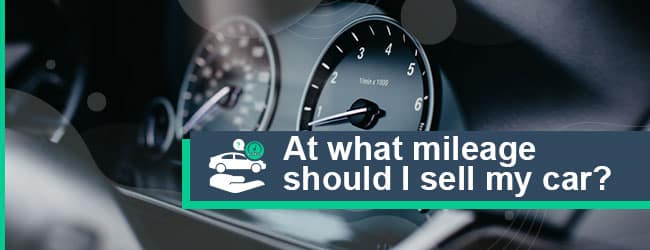Quick Answer:
If you hold on to your car for many years, it saves you money because its value doesn’t drop as quickly. But it’s wise to think about selling your car before it hits 100,000 or 200,000 miles. After reaching these milestones, it’s harder to sell the car, and it might need expensive fixes due to its age and use.
Key Takeaways:
- Timing and Mileage Considerations: Ideally, sell your car when it’s between 3 to 13 years old and before it reaches 100,000 to 200,000 miles. Beyond this, the car may require more costly maintenance and may be less appealing to buyers.
- Depreciation and Value: Cars depreciate fastest in the first few years, losing about 60% of their value within five years. Selling earlier might lead to higher financial loss per year compared to waiting a bit longer.
- Preparation for Sale: Enhance the car’s appearance and be transparent about its history, including mileage, repairs, and any issues, to attract potential buyers and justify your asking price.
- Market Timing: The best time to sell a car can vary depending on its type. For instance, SUVs and trucks may sell better in autumn and winter, while convertibles and sports cars are more in demand during spring and summer.
Best for Older & Damaged Cars

Buys used, damaged or junk cars
Free tow and no hidden fees
Pays by ACH trasfer or check
Top Pick for Junk Cars

Free, no-obligation cash offers
Offers free paperwork service
Pays on the spot upon pick up
Understanding Car’s Value Depreciation
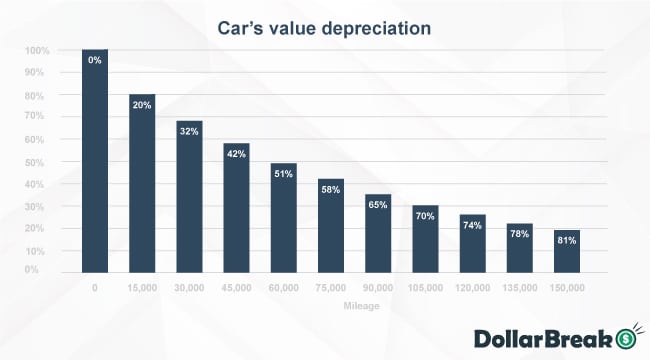
Depreciation reflects the rate at which a vehicle’s worth declines over time, and this rate can vary widely among different car brands and models.
A new car experiences its most dramatic loss in value immediately after purchase; it is estimated that its value decreases by an average of 9% as soon as it leaves the dealership.
The value of a car typically falls by 20% within the first year of ownership, followed by an average annual decline of 15% in the ensuing years. By the end of five years, the average car will have lost around 60% of its original value.
The number of miles a car has been driven is a key determinant of its depreciation, as it provides a clear indication of the vehicle’s age and the extent of wear and tear it has undergone. Generally, cars on the market are built to endure between 200,000 to 300,000 miles.
Up to 30,000 Miles
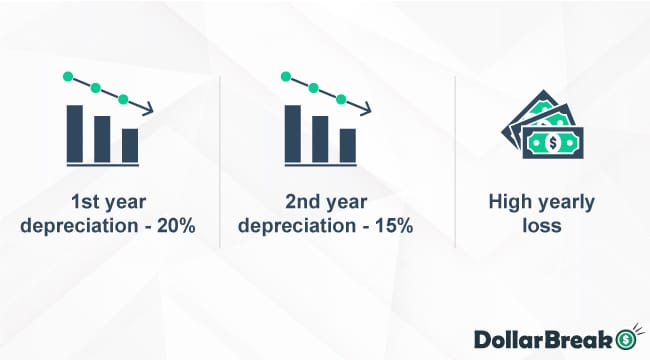
The Transportation Department says the average person in the U.S. drives about 13,572 miles every year. So, if a car has been driven for 30,000 miles, it’s likely just about 2 years old. Even though cars lose a lot of their value in the first couple of years, a 2-year-old car is still pretty fresh and can be sold for a good price.
However, selling a car when it’s only two years old might not be the best financial move. After two years, your car’s worth tends to drop by ~35%. That means if you bought a car for $30,000 and sold it two years later, you’re going to get around $10,500 less than what you paid.
This works out to a loss of about $5,250 each year.
If you wait to sell the car after having it for 7 years, the amount of money you lose each year will be around $3,000.
30,000 – 60,000 Miles
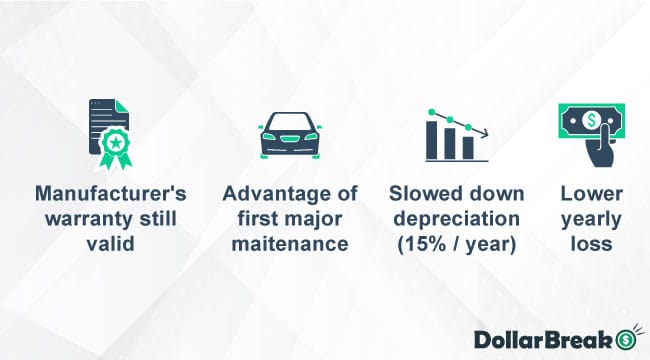
If your vehicle is under three years of age or has yet to surpass 36,000 miles, it’s likely still covered by the manufacturer’s original warranty. This coverage often contributes to a higher resale value.
Typically, once a vehicle hits the 30,000-mile mark, it’s due for significant upkeep. This includes changing fuel filters, inspecting coolant levels in the radiator, checking belts and hoses, evaluating suspension parts, and testing the air conditioning.
Expect to pay around $650 to $900 for this comprehensive service, which can enhance the vehicle’s value upon resale, offering an advantage over cars with lower mileage that hasn’t been as thoroughly inspected.
Between 30,000 and 60,000 miles, a car’s value depreciates at a more modest average rate of about 15% annually. This rate indicates a smaller yearly financial decline than what’s typically seen during a car’s initial years.
Consider a scenario where you buy a car for $30,000 and it accumulates 60,000 miles over four years. At this point, the value may have decreased by at least 50%, rendering the car worth around $15,000.
This equates to an annual loss of $3,750, which is more economical than the $5,250 annual loss you’d face by selling the vehicle after just two years of use.
Furthermore, a vehicle within the 2-5 year age range is less prone to serious breakdowns or the necessity for costly repairs, enhancing its appeal to prospective purchasers.
60,000 – 100,000 Miles
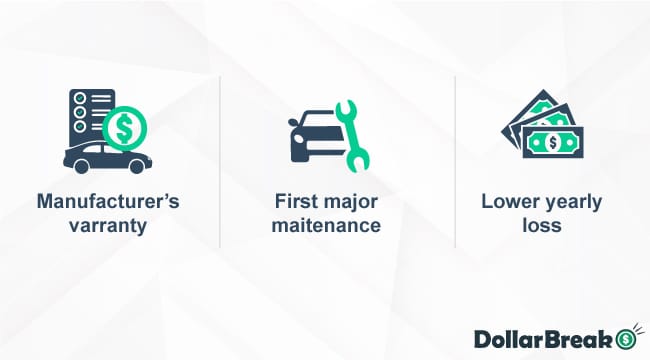
Cars that have been driven over 60,000 miles typically need more upkeep. You might have to replace parts like the timing belt, brakes, and tires, plus deal with other big repairs. The older the car gets, especially around 5 to 7 years old, the more often it needs to be fixed, and this can start costing you more each year.
Around that age, the car usually shows signs of wear and tear, which can reduce its value. Also, because new car models usually come out every few years, your car could be worth even less by the time you’re ready to sell it, as newer models may have been released twice in that period.
When a car’s mileage approaches or passes 100,000 miles, it can turn off many potential buyers. Many people just don’t want a car with that many miles on it, which can make it tougher to sell the car on your own.
100,000-200,000 Miles
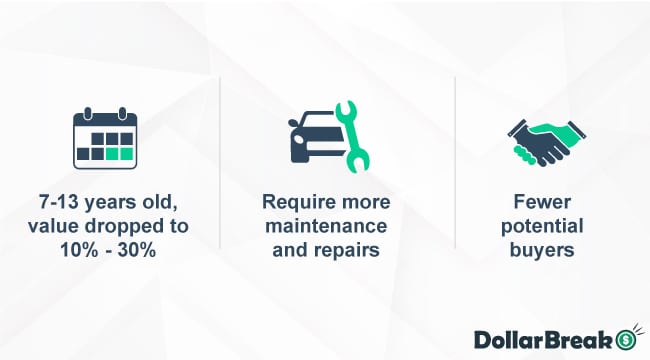
Cars with 100,000 to 200,000 miles are generally reliable yet may require more maintenance and repairs.
Typically, cars with this range of mileage are between seven and thirteen years old, and their worth tends to have diminished to a mere 10% to 30% of the initial purchase price.
Given their considerable mileage and years, potential buyers often approach these cars with caution, which can render the private sales process somewhat arduous.
To enhance your prospects of selling such a car, consider the following steps:
- Arrange for a pre-sale vehicle inspection to demonstrate to prospective buyers that the vehicle is in sound shape and free from significant problems.
- Set a fair and market-aware price for the vehicle, taking into account its age, mileage, overall condition, and current market rates.
- Be honest about the car’s history, including any incidents, maintenance history, or existing issues, when communicating with interested buyers.
- Be patient, as it may take longer to sell a car with high mileage, but you can still get a fair price.
200,000+ Miles
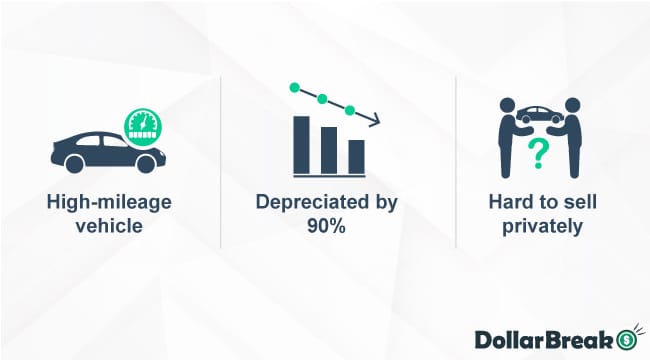
Vehicles that have accumulated over 200,000 miles are often classified as high-mileage cars. Such vehicles are typically prone to significant repairs and demand consistent upkeep.
A vehicle surpassing the 200,000-mile mark is usually aged 14 years or more and has depreciated by at least 90% from its original value. The market value at this stage is often much less than the cumulative cost of any necessary repairs and ongoing maintenance, resulting in a smaller circle of potential buyers.
If you’re considering selling a high-mileage vehicle, here are a few strategies to keep in mind:
- Adjust your sales expectations. Anticipate a modest selling price, particularly if the car is not in outstanding shape.
- Enhance the car’s appearance. Clean the vehicle thoroughly, both inside and out. Attend to minor aesthetic issues such as small dents, scratches, and paint chips.
- Be transparent about the vehicle’s history. Clearly communicate the car’s mileage, any previous repairs, and any existing problems to potential buyers.
- Obtain a pre-sale vehicle inspection. Presenting a mechanic’s inspection report can instill confidence in buyers about the car’s condition.
- Competitively price your vehicle. Look into the going rates for comparable models with high mileage using tools like Kelley Blue Book or Edmunds to understand your car’s market position better.
Best Age to Sell a Car?
Ideally, you should think about putting your car on the market when it’s aged between 3 and 13 years and before the odometer hits the 100,000 to 200,000-mile mark. Cars beyond this age and mileage tend to experience a steep drop in desirability as costly repairs and regular maintenance become more common.
Conversely, offloading a car that’s just 1 to 2 years old can be economically disadvantageous, as cars undergo the steepest value decline within the first year of ownership.
Best Time of the Year to Sell a Car
Timing with favorable market conditions can help you maximize your car’s value. Used cars are generally in higher demand towards the end of the year and the first quarter of the new year. This is because many potential buyers are looking for new vehicles to prepare for the upcoming winter season or have additional funds after receiving a tax return.
A new model release, which usually happens in autumn, can also impact the value of your car. It is best to sell before the new model comes out. It is estimated that the value can drop by 5% to 10% depending on new model improvements and changes and overall market demand.
Best seasons to sell a car:
- Autumn – Winter: SUVs, Crossovers, Trucks, All-Wheel-Drive cars, Minivans
- Spring – Summer: Convertibles, Sports cars, Hybrids and Electric Vehicles, Compact Cars



